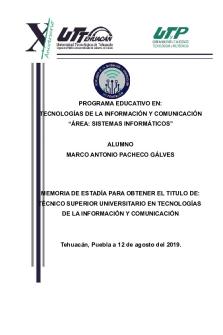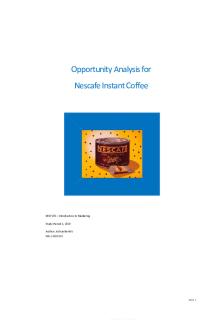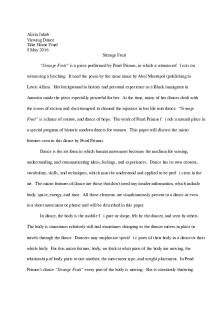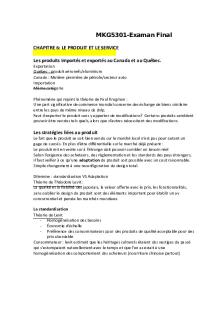Final Shushana Shimunova PDF

| Title | Final Shushana Shimunova |
|---|---|
| Author | Maritochka Iskhakova |
| Course | Introduction To Cinema |
| Institution | Hunter College CUNY |
| Pages | 6 |
| File Size | 124.5 KB |
| File Type | |
| Total Downloads | 49 |
| Total Views | 133 |
Summary
this is the final for Joshua Troxler....
Description
Quiz #4 (Final, Film 101) NAME: Shushana Shimunova
1. What post-war film movement matched the intention of Japan’s output of post-war genre films? (select, 5pt) a. German Expressionism b. White Telephone films of Italy c. Noir Films d. Social Documentaries
2. What does the perspective of the camera represent in SHARA? AND what belief system in Japan does this mirror? (short answer, 5pt) Throughout the film we are seeing the events play out through the eyes of Shun’s deceased brother Kei who disappeared when they were kids. He was always with the family although no one could see him. Because he was always their (which the audience becomes aware of at the end of the film) the viewers are filled with hope and possibilities of Kei one day meeting his family again. This belief that Kei could one day return mirrors the belief system of Buddhism which is a religion that can be found in Japan. In regards to the dead, Buddhism says that a person’s spirit remains close by and seeks out a new body and new life; this can be comforting to people who have lost their loved ones. In regards to Kei and his family, they can have the comfort that one day they will see Kei again, that this is only a temporary separation.
3. What narrative device is used directly after the opening scene of SHARA? (short answer, 5pt) After the scene where Kei disappears, the scene right after introduces a time jump (the narrative device). In my opinion this was done in order for the audience to see the effects of losing a loved one. Although time has moved on the family is still haunted by the memory of Kei. This is shown when the dad gets a call that they found Kei’s body. Even though so much time has passed we still see his brother Shun completely break down with his family. The rest of the film we can see that now that they have some closure, they are able to focus on other things like for Shun on his art and new sibling. 4. List three framing qualities of Japanese auteur Yasujirō Ozu. (short answer, 5pt) 1. Contemplative Pacing- Its similar to other Japanese film makers in that the pacing is very slow and methodical. His films are mostly about domestic situations that involved family conflict. He uses very simple movements which allow him to stretch out the pacing. His pacing style also reflects his belief in post world war 2 life in Japan. He wanted to show
how the past was still trickling through and how the country was still healing. He does this by having characters who served in the war talk about it. 2.Precise compositions- Ozu framing is very precise in that his framing is always the same in every single film that he directs. He is a very modernist director who has worked with a minimalist style. He is always showing you the boundries that he is willing to go through the frame. 3.Low camera angles- He was always putting the camera at the same distance every shot, in like the mid hip level. He did this because in Japan in the films he was making people sit on the floor to eat and have conversations and so he wanted the camera to mimic the posture of the Japanese people in their natural habitats of their homes and during times of celebration.
5. What shot is associated with Ozu’s filmmaking style? (select by bolding, 5pt) a. b. c. d. e.
Dutch Angle Pillow Shot Landscape Shot Dolly Shot Bird’s Eye Shot
6. What is the one major trait, or belief system, that links Kurosawa to the elements of Japanese Cinema? (short answer, 5pt) Kurosawa was a part of new Hollywoods obsession with foreign cinema, he greatly influenced Japanese cinema. His work also greatly influenced the studio filmmakers we see today. However, Kurosawa himself was influenced by a more genre based Hollywood. One major trait that linked Kurosawa to the elements of Japanese Cinema is that he combined elements of Japanese theatre (Noh drama and kabuki) into a lot of his films, they move in a more dramatic way that is often associated with theatre. Kurosawa was a risk taker, his shots were extremely grand and took a very long time to put together. He was also a humanist, so his films reflected a humanist attitude and had a huge focus on camera movement. (This was a quality of Japanese cinema). 7. What does poetic obscurity mean? How is this used in SHARA? Use a scene or character in your example. (short paragraph, 10 pt) Poetic obscurity often rejects narrative clarity for the sensual, becoming caught up in the wonder of the natural world. A lot of Japanese film directors were obsessed with using this like Naomi Kawase who directed and acted in SHARA. Japanese film directors loved it because it reflected not only their culture but also their spiritual beliefs. Throughout the entire film, we barely hear any dialogue it is through the natural world that we are told the story more. The fact that they don’t speak much to each other in the film I feel is done on purpose. This is because the family in the film went through a traumatic
experience of loosing a family member (son/brother), the fact that they barely communicate throughout the film brings more of an authenticity to the film itself. It helps the audience feel that this is a real family who is going through this horrible struggle because of how realistic the family behaves. The last scene is a great example of poetic obscurity; we are shown the camera moving through the house, out of the door and then soaring above. Although the movie doesn’t come out right and say it the audience is able to infer that the we are seeing this scene play out through the eyes of their dead family member Kei. From this we realize that the entire movie was from his perspective and that he was finally able to move on after he saw that his family were able to get the closure they needed. No words were used to reveal this to the audience only the natural world, this helped portray and emotional authenticity of the film to the viewers.
8. Why was Hayao Miyazaki obsessed with flying sequences in his films? (short answer, 5pt) The reason that he was so obsessed with flying scenes in his films was because of his father. His father designed wings for the zero airplanes during world war 2 for the Japanese army. So he was always growing up around aircraft and was fascinated with it. That’s why when he got older and became a director he liked to incorporate flying into his films. 9. Name and discuss three elements of speculative fiction in SPIRITED AWAY. Provide scene or character examples. (short answer, 10pt) a.Fantasy- The entire story is one big fantasy of a 10 year old girl who gets trapped in the spirit world and has to find her way out of it. In fact in this is shown in one of the first scenes when the family is traveling to their new home and they take a shortcut which leads them to a restaurant stocked with food. Chihiro’s parents begin to eat the food but she doesn’t and wanders off. When she returns he parents transformed into pigs, this was one element of speculative fiction in the film. b. Superhero- Chihiro is the hero of this story. In the beginning she was just a girl who had no idea what to do but after a while when she got the hang of life in the spirit world she accomplished amazing things. She saved Haku and by the end he is no longer under the control of Yubaba, she was able to find a way to turn her parents back into humans and she saved a lot of people from No face when he was swallowing people. c. Supernatural- The supernatural beings were the creatures that Chihiro came across during her time in the spirit world. We have Yubaba’s twin sister Zeniba, who in one scene transforms Yubaba’s son Boh into a mouse, creates a fake Boh and then transforms Yubaba’s bird into a smaller bird. Then we have Haku, a dragon spirit of the river and we also have Yubaba, who was able to control Haku, Chihiro and others by taking away their names from them.
10. What is one element of post-modernism at work in CAMERAPERSON. (short answer, 5pt)
Post-modernism is defined as “a revolt against traditions and views and cultures offered by modernist theories and aims to replace the existent innovation with a fresh new one that is more revolutionary and refined and an extraordinary version of the old.” It’s the opposite of modernism because it destroys boundaries. Johnson was working as a cameraperson for 30 years and she shot many great films. She was very involved with film making, but then she developed a very bad eye infection around 2014 and couldn’t shoot with the camera anymore so she had to put her life on pause. When she did she couldn’t stop thinking about what she had already shot in the past that weren’t used. She decided to put them together because they were a reflection of her experience as a cameraperson. What she ended up doing is she made a film that celebrated subjectivity, the point of view of the author, and it also documents us as mobile people. It pushed the question on to us of are we all camera-people? This is because the footage that she shot were extremely relatable and moving. Her ability to creat such an intriguing project by using personal footage allows the audience to take a look at what she is trying to convey. At times we were able to hear her crying from behind the camera like she did when she heard the story of the Kabul boy who was blinded in one eye. We could also hear her laughing, gasping or coaching an interview 9like she did with the nurse). We can hear her laughing with and questioning the Bosnian woman. All of these “imperfections” of the film make the audience lean more towards the post modernism idea because it makes it seem as if we are experiencing the entire film with her. We can sense her emotions when she shows her twins (happiness) and her sadness at having to see her mother succumb to Alzheimer’s. It is though these examples that we are shown elements of post modernism. She embraced the world like we would do with our camera, phones and with our ability to discover new things. She put herself in a position to travel and show different perspectives/viewpoints from around the world. Ultimately, we are shown Post modernism though how relatable Johnson made the film feel, because she was able to convey her emotions while filming which allowed us to feel as if we too are experiencing what she is. 11.1 What mode of documentary does CAMERAPERSON fall under? (select in bold, 5pt) a. f. g. h. i. j.
Expository Participatory Observational Performative Poetic Reflexive
11.2 Explain why you picked the mode you did for CAMERAPERSON (short paragraph, 10pt) Observational mode of documentary is defined by attempting to discover the ultimate truth of a subject by acting as a fly on the wall. Observing serving the subjects real life without interrupting. Cameraperson is a collection of footage that was originally shot for films that Johnson was working on during her career. Throughout the film we are shown scenes and images that Johnson has observed which have nothing to do with each other. We are shown many scenes which Johnson has observed over the years. An old Bosnian woman accepting a compliment, a young African-American woman in an
abortion clinic, a young boy in Kabul whose left eye was blinded in a bomb blast and many more. Her work takes her to places that were filled with violence, death, grief and destruction, but through it all she was their observing, bearing witness to watch she sees. We are rarely shown Johnson herself, but instead in a handful of scenes we are shown Johnson’s mother who is suffering from Alzheimer’s and we are shown Johnson’s twin boys. This makes one think the movie is for us, the audience to understand what many different people in the world face everyday or is it for Johnson herself. In this I mean that maybe she made this film because she is scared that she too will succumb to Alzheimer’s and she wants to have this film to be her memory, that’s why she chose to include her own family into it. Overall, this documentary is observational because we are shown countless scenes in which Johnson observes and absorbs the world around her. 12. In THIS IS NOT A FILM why is he under house arrest? (short answer, 5pt) Pahini was convicted by Iran’s Islamic republic of making propaganda against the system. In his films he would showcase a realistic perspective on life in Iran, on the hardships on the woman, children and the poor. After many years of being in conflict with the Iranian government over his films he was arrested and sentenced to six years in prison and a 20 year ban on making movies. That’s why in his movie this is not a film he had his friend direct most of it and he was actually able to smuggle it out on a flash drive hidden in a cake. 13. What is one element of modernism displayed in THIS IS NOT A FILM? (short answer, 5pt) One element of modernism that is displayed in THIS IS NOT A FILM is a fascination with everyday life, perception, time and the kaleidoscope and fractured experience of urban space. Modernism also showcases boundaries. In this film we were able to see the everyday life of the director Pahini as he is stuck inside of his house because he is on house arrest. He is on house arrest because he maid films about what living in Iran was actually like, Iran took this to be propaganda and convicted him. Everything about this film felt extremely raw, personal and real. We as the audience are able to see what Pahini actually goes through as he awaits news of the courts appeal for a six year sentence (he is told in the beginning that his sentence may be reduced, it isn’t though). Since he wasn’t allowed to make films he invited his friend to come to his apartment and the two of them spend the better part of a week what kind of film they can make within the limitations of Pahini’s sentence. We see him going through the motions of everyday life, him waiting his breakfast, drinking tea talking on the phone with his wife. He tends to his daughters pet iguana and watches bits of movies he made when he was allowed to film. Sometimes we are shown his anxiety, isolation and frustration. The audience was able to feel this through the fact that some of it was shot on an iPhone. This made the film feel more real and helps the audience feel exactly what Pahini feels in the moment. It’s just like anyone who takes out their phones randomly to capture a moment, it feels more raw and personal like that. He also lets his frustration shine through when he watches footage of his own past work, we can feel his longing to be able to openly film like that again. Overall, THIS IS NOT A FILM is a modernist film, we are shown this through how the audience is able to take a peek into Pahini’s everyday life and emotions. 14. What does THIS IS NOT A FILM have in common with René Magritte painting titled THIS IS NOT A PIPE? (short answer, 5pt)
In the time of this film Pahini was put under house arrest and not allowed to make any films because he was thought to be a danger to the society and to the cultural movement in the country. This film is definitely a pressure cooker film and feels like its working up to a certain point. At this time there were a lot of protests going on about the country because of the presidential election and these protests were also going on outside of his home so in a certain sense it was almost safer for him to be in doors. However at the same time he was put in doors for those same protests that he conveyed through his films. In 1929 Magritte made a very provocative painting called THIS IS NOT A PIPE and it is meant to make us question our assumptions of words and images. There is a connection between THIS IS NOT A FILM and THIS IS NOT A PIPE they both cause the audience to look deeper into each piece, to question what we are watching. Of course this is not a film is defiantly a film, but its up to us to question and interpret each part of it. In many ways Pahini has a political conversation with this title, he isn’t allowed to make a film so he wants to make it very clear in the title of his movie that its not what he’s doing. It forces the audience to ask that question of association, which is similar to this is not a pipe. Magritte wants us to also look deeper and push the boundaries of art. 15. What is one coming-of-age element at play in SPIRITED AWAY? (short paragraph, 10pt) One coming of age element at play in SPIRITED AWAY is maturity/growth. In the beginning we are introduced to Chihiro as she lays in the backseat while her parents are driving. She had that laziness that only children have the luxury of. She isn’t capable of doing anything on her own, all she knew was how to whine and then she would get what she wanted. But, when she came into the spirit world she realized that was not going to cut it. She is faced with many challenges; her parents are pigs so she is on her own, she is in a strange world that she doesn’t understand and she is pushed around by Yubaba because she took away her name. When Chihiro becomes Sen and starts to work at the bathhouse she works very poorly and lazily, still retaining those childish qualities in her. However, as time begins to pass and she gets more acclimated to the living in the spirit world she begins to work diligently and even impresses everyone when she was able to wash the stink spirit until his true identity is revealed. It was through hard work and her time in the spirit world that transformed Chihoro into a stronger person. After her experience in the spirit world the audience can clearly see that the events left her looking and feeling more mature. We could see the growth take place within her through her actions because she decided that no one will fix her problems for her, if she wants things to go back to the way they used to be she needs to do something. In the end she is able to put everything back to the way it was and save her parents. She was able to change so drastically because the environment gave her only two choices, either grow up and save your parents or stay the way you are and live the rest of your life in the spirit world. Ultimately she made the right choice and saved her parents....
Similar Free PDFs

Final Shushana Shimunova
- 6 Pages

Final
- 9 Pages

Tesina-Final reevisado Final
- 55 Pages

🎄🎄🎄🎄🎄🎄 - Final
- 2 Pages

Opportunity Analysis final final
- 12 Pages

Examen final bioquímica final
- 12 Pages

THESIS FINAL FINAL
- 84 Pages

Final
- 3 Pages

Final
- 16 Pages

Final
- 37 Pages

Flipped-final - FLIPPED FINAL
- 6 Pages

Final Final Essay Africa
- 8 Pages

Examen final bioquímica final
- 12 Pages

Trabajo Final CAF2 Final
- 24 Pages

Final Exam -Evaluacion final
- 42 Pages

Practice-final - Practice final
- 7 Pages
Popular Institutions
- Tinajero National High School - Annex
- Politeknik Caltex Riau
- Yokohama City University
- SGT University
- University of Al-Qadisiyah
- Divine Word College of Vigan
- Techniek College Rotterdam
- Universidade de Santiago
- Universiti Teknologi MARA Cawangan Johor Kampus Pasir Gudang
- Poltekkes Kemenkes Yogyakarta
- Baguio City National High School
- Colegio san marcos
- preparatoria uno
- Centro de Bachillerato Tecnológico Industrial y de Servicios No. 107
- Dalian Maritime University
- Quang Trung Secondary School
- Colegio Tecnológico en Informática
- Corporación Regional de Educación Superior
- Grupo CEDVA
- Dar Al Uloom University
- Centro de Estudios Preuniversitarios de la Universidad Nacional de Ingeniería
- 上智大学
- Aakash International School, Nuna Majara
- San Felipe Neri Catholic School
- Kang Chiao International School - New Taipei City
- Misamis Occidental National High School
- Institución Educativa Escuela Normal Juan Ladrilleros
- Kolehiyo ng Pantukan
- Batanes State College
- Instituto Continental
- Sekolah Menengah Kejuruan Kesehatan Kaltara (Tarakan)
- Colegio de La Inmaculada Concepcion - Cebu